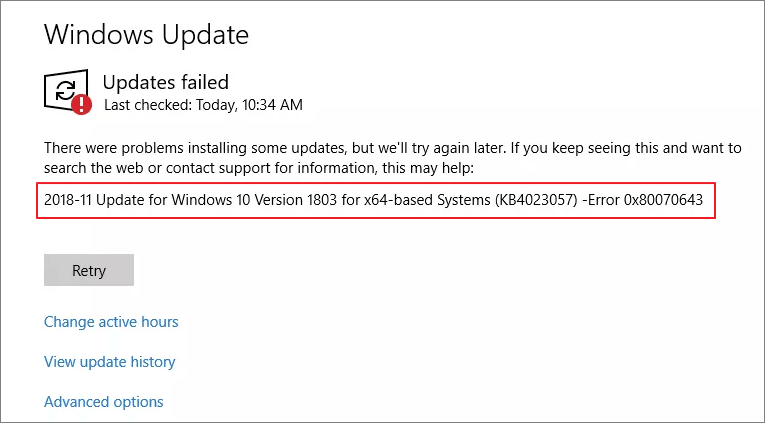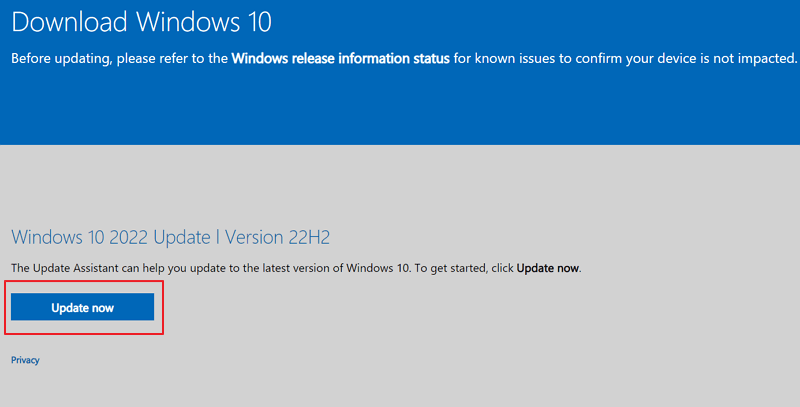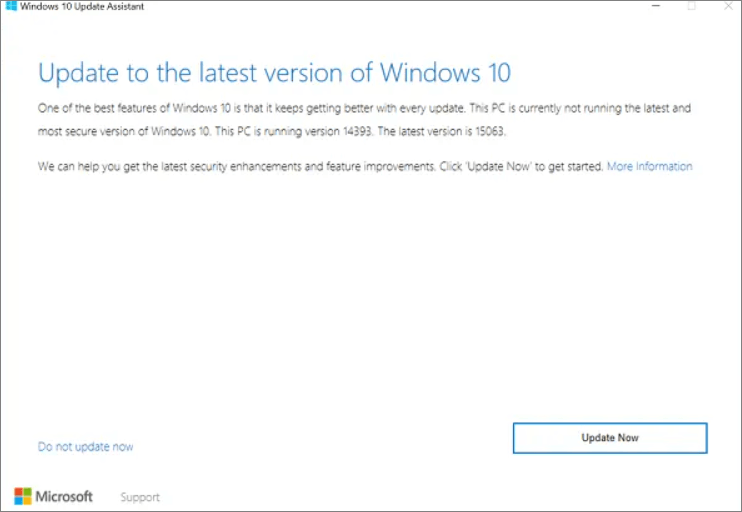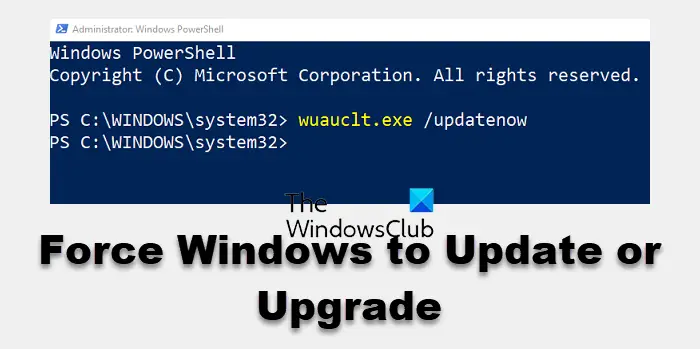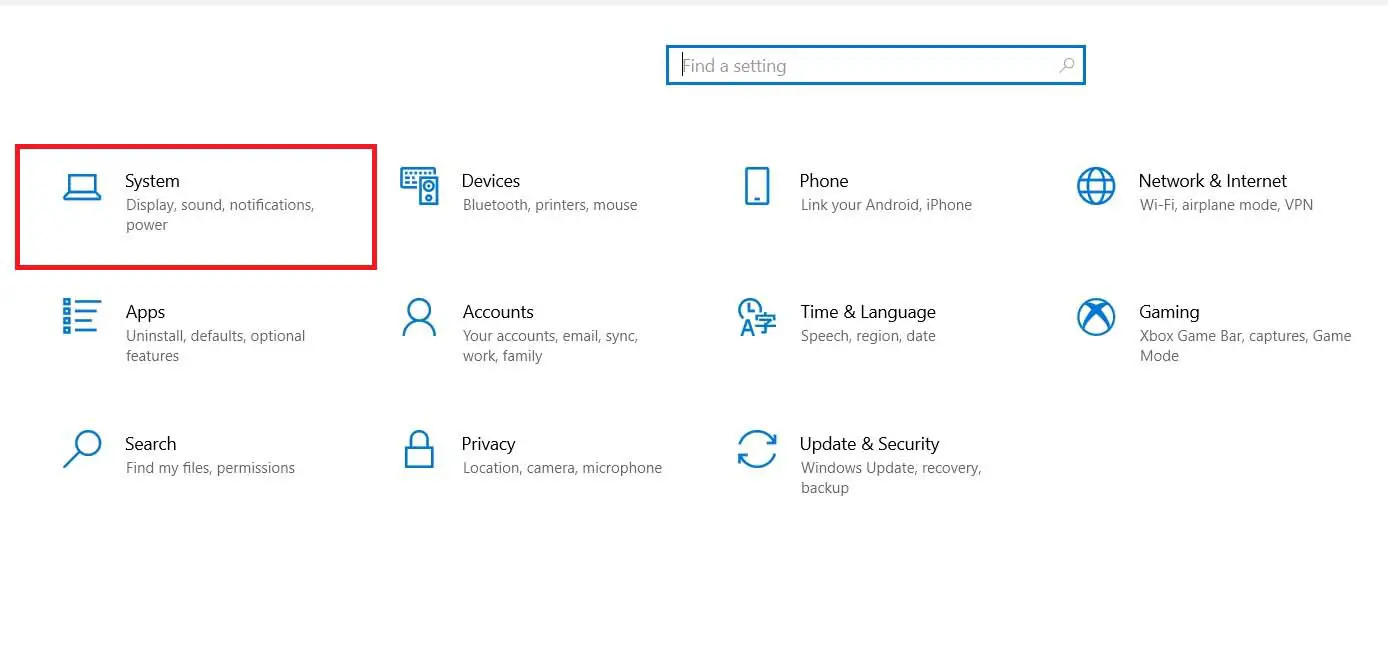Are you looking to get the most out of your Windows 11/10 experience? Then you should ensure that your operating system is up-to-date with the latest build. Keeping up with the latest version of Windows 11/10 ensures you have access to all of its features, security fixes, and many other improvements. In this blog post, we’ll walk through how to force update Windows 10, so you can maximize performance on your PC.
| Workable Solutions | Step-by-step Troubleshooting |
|---|---|
| Force Update via Microsoft |
|
| Force Update Windows 10 with CMD |
|
Tip 1. Force Update Windows 10 to the Latest Build from Microsoft
There are times that you download Windows 10 update, but Windows 10 update fails with error code 0x80070643 or other errors. Thus, you can’t update Windows 10 to the newest version in this way.
However, you can free download Windows 10 and force update to the newest Microsoft version. You can watch this video to force update Windows 10 to the newest version.
- 0:00 Introduction
- 0:46 How to update Windows 10
- 3:11 What to do after Windows 10 update
If you prefer a step-by-step guide, follow the steps below.
Step 1. Go to the Microsoft website and click «Update now».
Step 2. Download the latest version of Windows 10 and open the file to install.
Step 3. Then, Windows 10 Update Assistant pops up. Follow the on-screen operations and force update Windows 10.
After the update, restart your computer and check your PC.
Tip 2. How to Force Update Windows 10 with CMD
For users confident with utilizing the command line viewer, force updating Windows 10 with CMD is a quick and effective way to install the latest updates. The process works by delivering a special command that downloads and installs all pending Windows updates. Follow the steps below to force update Windows 10 to the newest version.
Step 1. Run Command Prompt as administrator from the search box.
Step 2. Type wuauclt.exe /updatenow and hit Enter.
This command will force Windows 10 to check for updates and start downloading.
If you want to learn more details about Windows 10 force update, watch this video.
- 0:00 Introduction
- 0:22 Force update Windows 10
How to Recover Lost Data After Windows 10 Update
After the force update, you may lose data on your laptop or PC. You can recover lost files after Windows 10 update. All you need is EaseUS Data Recovery Wizard. This data recovery software works well in recovering deleted, formatted and other data with simple clicks.
- It can recover data from a hard drive, SSD, SD card, USB flash drive, and more.
- This software supports data recovery from Windows 11/10/8.1/8/7.
- You can perform photo recovery, video recovery, Word recovery, and file recovery with it.
Download this data recovery software and recover data after Windows 10 update.
Conclusion
A forced update is the last thing you want to do, but if you follow Tip 1 or 2 from our blog post, you can make sure your Windows 10 is up-to-date. If, by misfortune, you lost some data after Windows 10 update, don’t worry! Follow our tips to recover lost data and get your files back.
Force Windows 10 Update FAQs
Read the questions and answers below to get additional help.
1. Why is Windows 10 not getting updated?
Here are the reasons why Windows 10 won’t update:
- A file needed by Windows Update is likely damaged or missing
- A driver or other software on your PC isn’t compatible with Windows 10
- Your PC couldn’t connect to the Windows Update servers
- Your PC doesn’t meet the minimum requirements to download or install the upgrade to Windows 10
2. How do I force Windows 10 to update from the command line?
Follow the steps below to force Windows update with the command line:
- Type cmd in the search box, choose Run as administrator, and click Yes to continue.
- Type wuauclt.exe /updatenow and hit Enter.
- This command will force Windows Update to check for updates and start downloading.
3. How can I stop Windows 10 from an automatic update?
To disable Windows 10 updates in every way:
- Manually Disable Windows Update
- Change the Settings of the Group Policy Editor
- Meter Your Network Connection
- Change Update Settings Using Registry
Microsoft announces a new Windows 10 build and everyone but you are getting their devices updated. When you check the Windows Update section in the Settings app, Windows says your device is up-to-date. Of course, there’s a new Windows version but you’re stuck on an older version. We explain why this happens, and how you can force a Windows 10 update.
Microsoft rolls out Windows 10 updates in trickles—not everyone receives an update at the same time. When a Windows Update is available to the public, you may get the update immediately, or it may take days sometimes. However, if the delay is running into weeks or taking longer than usual, the troubleshooting techniques in this guide will help you force install a Windows 10 update on your device.
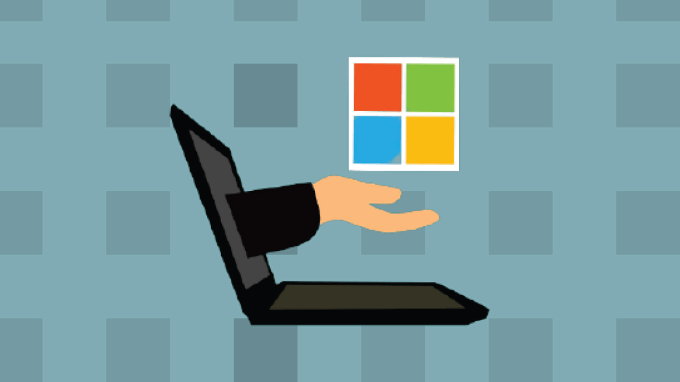
Do You Have the Latest Windows 10 Version?
Before you try to force install an update, you need to first confirm that your device truly isn’t up-to-date. Go to Settings > System > About and scroll to the Windows specifications section, and take note of the OS build and version.

Now, head to the official Windows 10 release information page, and compare your PC’s OS details with the latest Windows 10 version and build number on the list. If you don’t have the latest version, proceed to the next section to learn how to manually trigger a Windows update.
There are several factors that delay a Windows 10 update. It could be due to low storage space, failure of essential system processes, and so on. If storage is the problem, the Windows Update agent will display an error informing you to free up additional storage space. Other factors, on the other hand, can be difficult to pinpoint.
We’ve compiled some possible ways to force install a Windows Update by eliminating issues causing the delay.
1. Restart the Windows Update Service
This service handles the delivery of software updates to Windows devices. Your PC may fail to automatically download or install a new update if the service is malfunctioning or inactive. Restarting the Windows Update Service can force Windows 10 to install an update. Follow the steps below to get it done.
1. Type services in the Windows Search bar and select Services in the results.
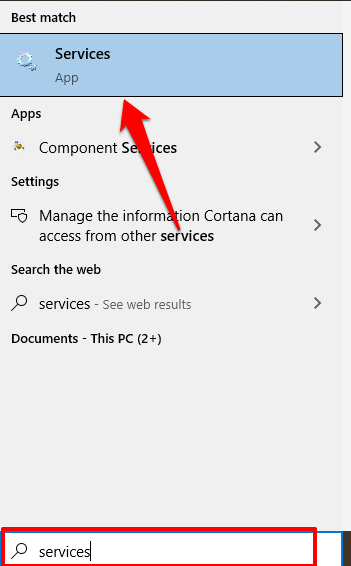
2. Right-click Windows Update and select Restart.

Return to the Windows Updates section in the Settings app and check if a new update is available for your computer.
2. Restart the Background Intelligent Transfer Service
The Windows Update Service depends on the Background Intelligent Transfer Service (BITS) to download updates from the Microsoft servers. Should BITS stop working, your PC may be unable to download and install updates. Restart the service and check if that fixes the problem.
1. Type services in the Windows Search bar and select Services.
2. Right-click Background Intelligent Transfer Service and select Restart.
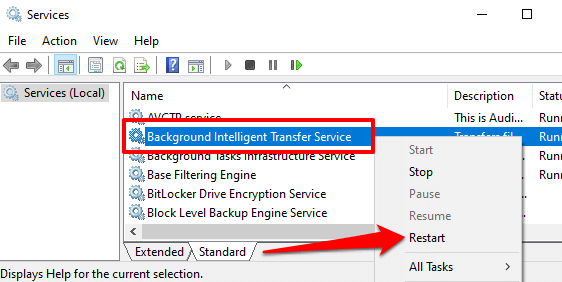
If the service doesn’t start, try other troubleshooting techniques in this guide on fixing issues with the Background Intelligent Transfer Service.
3. Delete the Windows Update Folder
The Software Distribution folder houses the necessary files required to install Windows on your computer. If you’re yet to receive a globally available update, deleting the content of the folder could force Windows to acquire and install the latest OS build. Windows will automatically recreate the folder and re-download the files needed to update your PC.

Before you proceed, there’s something important to note. The Software Distribution folder also holds files containing your PC’s Windows Update history. Therefore, deleting the folder means you can’t roll back to a previous Windows version.
Additionally, updating your computer may take longer than usual. That’s because the Windows Update Service must first repopulate the Software Distribution folder before it installs any available update.
To delete the Software Distribution folder or its content, you need to first stop the Windows Update Service and Background Intelligent Transfer Service.
1. Right-click the Start menu and select Command Prompt (Admin).
2. Paste the command below in the console and press Enter to stop the Windows Update Service
net stop wuauserv
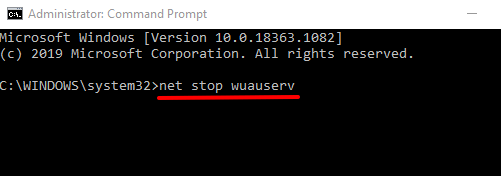
3. Paste the next command and press Enter. That’ll terminate the Background Intelligent Transfer Service.
net stop bits
4. Launch the File Explorer and go to Local Disk (C:) > Windows > Software Distribution and delete all items in the folder.
If you can’t delete the files, or you’re getting an error message, restart your computer and try again. After deleting the Software Distribution files or folder, proceed to the next step to restart the background services you stopped earlier.
5. Open Command Prompt as an administrator and paste the command below in the console to restart the Windows Update Service.
net start wuauserv

6. Afterward, paste this next command and press Enter to restart the Background Intelligent Transfer Service.
net start bits

Windows will automatically re-download the files required to update your computer to the latest OS build. Now check if the latest Windows build is available.
4. Perform Windows Update Cleanup
When you install newer Windows 10 builds, Windows stores the system files of older updates on your device. This lets you uninstall an update or roll back the operating system to a previous version. However, these system files often consume storage space and cause problems with future Windows Updates.
Use the Disk Cleanup tool to perform a Windows Update cleanup and try installing the update again.
1. Type disk cleanup in the Windows Search bar and select Disk Cleanup in the result.

Wait for the tool to calculate how much freeable space you have on your PC. This might take some seconds, or minutes—depending on your PC’s storage size and configuration.
2. Click the Clean up system files button.
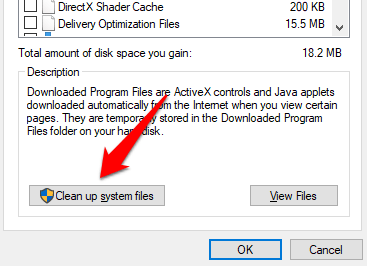
The Disk Cleanup tool will recalculate the freeable storage space on your local disk, taking system files into account this time.
3. Check Windows Update Cleanup, uncheck other options, and select OK to proceed.
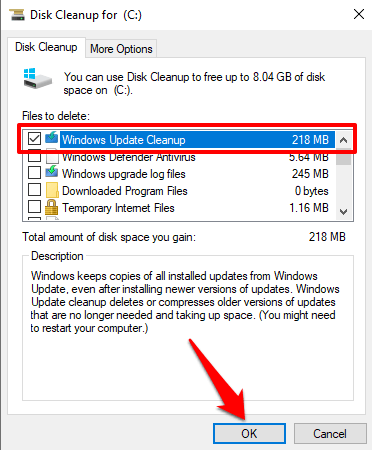
5. Run Windows Update Troubleshooter
If you still can’t install a Windows Update after deleting all associated files, try using the built-in troubleshooting tool to diagnose and fix issues delaying the update. Go to Settings > Update & Security > Troubleshoot > Windows Update and click the Run the troubleshooter button.
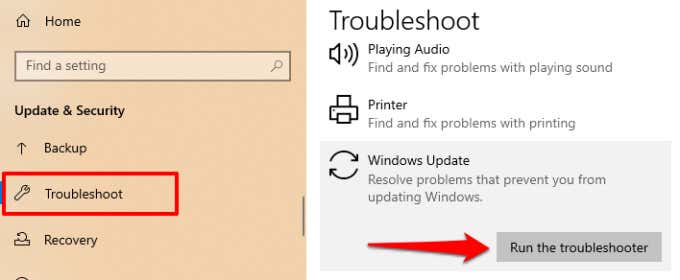
The Windows Update Troubleshooter will scan for issues preventing your computer from installing an update.
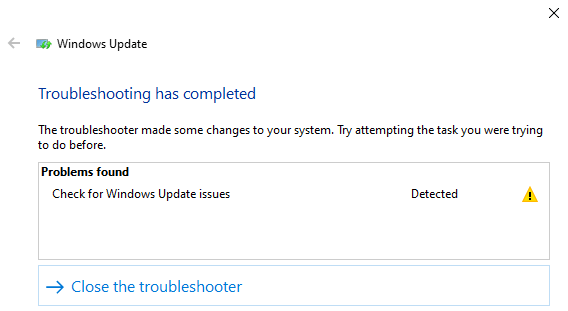
When the diagnosis is complete, go to the Windows Update menu and check if you can now install an update. If nothing changes, restart your computer and try again.
6. Use the Windows Update Assistant
Not only can the Windows Update Assistant force install an update, but it’ll also run a compatibility scan to ensure your computer meets the requirements for the latest Windows 10 build.

Head to the Windows 10 Download page on your browser and select the Update now button to download the Windows Update Assistant setup file.
Double-click the setup file to install and launch the Windows Update Assistant. Select Update now to proceed.

The tool will check if your device is compatible with the latest Windows 10 version. Select Next and the Update Assistant will download and install the update on your PC. This may take a while, depending on the size of the update, your internet speed, and other factors.
Sometimes, You Can’t Force Windows Updates
You may be unable to force a Windows Update if Microsoft places a Safeguard Hold on your PC. A “safeguard hold” is a technique used to temporarily prevent users from installing an unstable or potentially harmful update.
So, how do you identify a safeguard hold? Go to Settings > Updates & Security > Windows Update. If there’s a safeguard hold on your computer, you’ll find this error message on the page: “The Windows 10 Update is on its way. Once it’s ready for your device, you’ll see the update available on this page.”
Microsoft strongly advises against opting out of a safeguard hold—i.e., manually installing an update when there are known performance issues with the update. Wait until the issues with the update are fixed or when the safeguard is lifted.
Table of Contents
1
Windows updates are essential for maintaining the performance and security of your Windows 10 computer. Microsoft regularly releases updates to address bugs, introduce new features, and patch security vulnerabilities. However, sometimes these updates may not get installed automatically, leaving your system vulnerable to issues. In this blog post, we will guide you on how to force a Windows update on Windows 10, ensuring that your computer stays up to date and secure.
Video Tutorial:
There are several reasons why you might need to force a Windows update on your Windows 10 computer. Here are a few:
1. Security: Windows updates often include patches for security vulnerabilities that can be exploited by hackers and malware. By forcing a Windows update, you ensure that your computer is protected against the latest threats.
2. Bug Fixes: Updates also address various bugs and performance issues in the operating system. By installing the latest updates, you can benefit from improved stability and performance on your Windows 10 computer.
3. New Features: Windows updates sometimes introduce new features that enhance the overall user experience. By keeping your system up to date, you can take advantage of these new features and enhancements.
4. Compatibility: Some software and hardware may require specific Windows updates to function correctly. By forcing a Windows update, you ensure that your system remains compatible with the latest software and hardware releases.
Method 1: Windows Update Settings
The first method to force a Windows update on Windows 10 is through the Windows Update settings. Here are the steps:
1. Open the «Settings» app by clicking on Start and then selecting the gear icon.
2. In the Settings window, click on «Update & Security.«
3. From the left sidebar, click on «Windows Update.«
4. Click on the «Check for updates» button.
5. Windows will now check for available updates. If updates are found, they will be downloaded and installed automatically.
6. Restart your computer after the updates have been installed.
Pros:
– Easy and straightforward method.
– Windows checks for updates automatically, so it’s convenient.
– You can choose to install updates immediately or schedule them for a later time.
Cons:
– This method relies on Windows automatically checking for updates, so it may not work if the automatic updates feature is disabled.
– It may take some time for Windows to check for updates, especially if you haven’t done it in a while.
Method 2: Windows Update Troubleshooter
If the previous method didn’t force the Windows update, you can try using the Windows Update Troubleshooter. Here’s how:
1. Press the Windows key + I on your keyboard to open the Settings app.
2. Click on «Update & Security.«
3. Navigate to the «Troubleshoot» section.
4. In the «Get up and running» section, click on «Windows Update.«
5. Click on the «Run the troubleshooter» button.
6. Follow the on-screen instructions to diagnose and resolve any issues that might be preventing Windows updates.
7. Restart your computer after troubleshooting is complete.
Pros:
– The Windows Update Troubleshooter can identify and fix common issues related to Windows updates.
– It provides a guided troubleshooting experience, making it easy for users to resolve problems.
Cons:
– The troubleshooter might not be able to fix complex issues that require advanced troubleshooting.
– Not all update-related issues can be resolved using the troubleshooter.
Method 3: Windows Update Assistant
Another option to force a Windows update on Windows 10 is by using the Windows Update Assistant tool. Follow these steps:
1. Visit the official Microsoft website and search for «Windows Update Assistant.«
2. Download the Windows Update Assistant tool from the official Microsoft website.
3. Run the downloaded file to launch the Windows Update Assistant.
4. Click on the «Update now» button.
5. The Windows Update Assistant will check for available updates and prompt you to install them.
6. Follow the on-screen instructions to complete the update process.
7. Restart your computer after the updates have been installed.
Pros:
– The Windows Update Assistant tool allows you to manually initiate the update process.
– It ensures that you are running the latest version of Windows, even if the automatic update feature is disabled.
Cons:
– The Windows Update Assistant tool needs to be downloaded and installed separately, which may not be convenient for some users.
– It may take some time for the tool to download and install the updates, depending on your internet connection speed.
Method 4: Command Prompt
Using Microsoft Windows Updates Catalog
If the previous methods didn’t work, you can try using the Command Prompt to force a Windows update using the Microsoft Windows Updates Catalog. Here’s how:
1. Press the Windows key + X on your keyboard and select «Command Prompt (Admin)» or «Windows PowerShell (Admin)» from the menu.
2. In the Command Prompt window, type «net stop wuauserv» (without quotes) and press Enter. This command stops the Windows Update service.
3. Open your web browser and visit the Microsoft Windows Updates Catalog website.
4. Search for the Windows update that you want to download and install.
5. Click on the download link for the update that matches your system architecture (32-bit or 64-bit).
6. Save the downloaded update file to a location on your computer.
7. In the Command Prompt window, type «net start wuauserv» (without quotes) and press Enter. This command starts the Windows Update service.
8. Navigate to the location where you saved the downloaded update file.
9. Double-click on the update file to install it manually.
10. Follow the on-screen instructions to complete the installation.
11. Restart your computer after the update has been installed.
Pros:
– Allows you to manually download and install specific Windows updates.
– You have more control over the update process.
Cons:
– This method requires some technical knowledge and familiarity with the Command Prompt.
– It may not be suitable for beginners or users who are not comfortable working with command-line tools.
What to Do If You Can’t Force A Windows Update on Windows 10
If you are unable to force a Windows update using the methods mentioned above, here are a few fixes you can try:
1. Restart your computer: Sometimes a simple restart can help resolve issues with Windows updates.
2. Check your internet connection: Ensure that you have a stable internet connection as updates require a reliable internet connection for downloading.
3. Temporarily disable antivirus software: Antivirus software can sometimes interfere with the update process. Try disabling it temporarily and then attempt to force the update again.
4. Reset Windows Update components: You can use the Windows Update Troubleshooter or follow Microsoft’s official guide to reset the Windows Update components, which might help resolve underlying issues.
5. Seek professional assistance: If all else fails, it might be best to seek help from a professional computer technician who can diagnose and fix any underlying issues with your Windows 10 computer.
Bonus Tips
Here are three bonus tips to enhance your Windows updating experience:
1. Schedule updates during off-peak hours: Windows allows you to set active hours during which it won’t automatically restart your computer for updates. Adjust these hours to a time when you are not actively using your computer to avoid interruptions.
2. Enable automatic updates: While we have discussed methods to force updates manually, enabling automatic updates ensures that your system stays up to date without any manual intervention.
3. Keep backups: Before forcing a Windows update or making any significant system changes, it’s always a good practice to create a backup of your important files and data.
5 FAQs
Q1: Why can’t I force a Windows update using the Windows Update settings?
A: If you can’t force a Windows update using the Windows Update settings, it could be due to disabled automatic updates, underlying issues with the Windows Update service, or other conflicting software on your computer. Try using alternative methods mentioned in this blog post to force the update.
Q2: Can I force a Windows update on Windows 10 Home edition?
A: Yes, the methods mentioned in this blog post can be used to force a Windows update on both Windows 10 Home and Windows 10 Pro editions.
Q3: Are there any risks associated with forcing a Windows update?
A: Generally, forcing a Windows update doesn’t pose any significant risks. However, it’s always a good practice to create backups of your important data to avoid potential data loss during the update process.
Q4: How often should I force a Windows update?
A: It’s recommended to keep your Windows 10 computer up to date by regularly installing updates. You can schedule automatic updates or manually force updates whenever new updates become available.
Q5: Can I roll back a forced Windows update?
A: If you encounter issues after a forced Windows update, Windows provides an option to roll back to a previous version within a certain time frame. This allows you to revert the changes made during the update and restore your system to its previous state.
Final Thoughts
Keeping your Windows 10 computer up to date with the latest updates is crucial for security, performance, and compatibility. By following the methods mentioned in this blog post, you can force a Windows update when automatic updates fail or are disabled. Remember to regularly check for available updates and keep your system protected against the latest threats.
Download Windows Speedup Tool to fix errors and make PC run faster
When Microsoft rolls out Windows 11/10 feature updates, they do it in phases. It means that they are not available to everyone right away. While it is possible to force update Windows 11 or Windows 10, you should understand a few things. The rollout depends on many criteria depending on how many devices were successfully tested, driver compatibility confirmation from OEM, and hardware requirements.
There are two possibilities. One that your computer is eligible, and there is only a delay of one or two days or maybe a few hours. Secondly, there is an issue. However, since you have decided to update now, let’s find out how to force update.
To force Windows 11/10 to Update or Upgrade you can follow these steps:
Before doing this, make sure you create a system restore point. If there is a problem, you can always rollback to the earlier version.
Next, clear the Software distribution folder which is available at C:\Windows\SoftwareDistribution\Download. It is best that you rename it to something else.
Now, open Command Prompt with administrator privileges. We will use wuauclt.exe. This is the Windows Update Auto Update Client and it allows you control over the functioning of the Windows Update Agent.
Type the following command and hit Enter:
wuauclt.exe /updatenow
This command will force Windows Update to check for updates, and start downloading.
Now when you go to Settings > Update and Security > Windows Update, you should see that Windows Update has automatically triggered checking for a new update. This will help you get through the waiting list, and the download should start anytime.
That said, here is a small risk. There is a reason why Microsoft doesn’t let everyone download Windows Updates on demand. Sometimes the update is only available for computers that have not been reported for any issue. Sometimes, there are specific driver issues.
When you either follow this method or keep hitting the download button manually, it can even roll out beta updates for your computer. So stay warned if you are going to force update Windows 11/10.
You can also force Windows 11 to upgrade immediately using the following methods:
- Using Windows 11 Installation Assistant
- Download Windows 11 Disk Image (ISO) file from Microsoft
- Create Windows 11 bootable installation media using Media Creation Tool.
Anand Khanse is the Admin of TheWindowsClub.com, a 10-year Microsoft MVP (2006-16) & a Windows Insider MVP (2016-2022). Please read the entire post & the comments first, create a System Restore Point before making any changes to your system & be careful about any 3rd-party offers while installing freeware.
Throughout this article, we’re going through six different ways in how to force a Windows 10 update.
Microsoft keeps releasing new Windows updates to patch existing bugs, offer novel features, and fix security issues within the operating system.
While these updates are available to the public and often readily installed by default, some Windows users might not get them immediately for varied reasons.
Even if they get the update option in Settings, it might not run properly or take an unusual amount of time for installation.
If these issues sound familiar to you, your computer is probably stuck on an outdated version.
Fortunately, there is nothing to worry about, as this guide will show you how to force a Windows update manually if it doesn’t install automatically on your Windows 10 device.
Additionally, we will also disclose possible reasons why your Windows Update feature might not be functioning properly.
So, let’s begin!
Table of Contents
- How to force a Windows 10 update in six different ways
- Is your PC running on the latest Windows version?
- Why does Windows need force update?
- Restart the Windows Update Service
- Restart the Background Intelligent Transfer Service
- Perform Disk Cleanup
- Use Command Line to force Windows Update
- Using the Windows 10 Update Assistant
- Force Windows Updates via WuInstall
- Still unable to force Windows Updates?
- Wrap up
How to force a Windows 10 update in six different ways
Is your PC running on the latest Windows version?
Before you force a Windows 10 update, it’s essential to understand whether your device truly needs an update or not. Hence, to confirm which version your device is running on, follow the below steps:
- From the “Start menu“, open “Settings“. Alternatively, you can press the “Windows+I” keys to launch the Settings app;
- Click on “System” followed by “About“;
- Take note of the version and OS build under the “Windows specifications” section;

- Now, visit the official Windows 10 release information page and check the latest version of Windows 10. Once you have confirmed that your PC is running on an outdated version, you can trigger a Windows update using the methods described in this guide.
Why does Windows need force update?
Windows updates are essential for a smooth user experience since Microsoft continuously releases updates to fix issues in the previous versions.
However, sometimes your system can delay a Windows 10 update due to a software conflict, insufficient storage space, or freezing of some system processes.
If the Windows update is experiencing a delay due to space issues, you can clean up the system by removing a bunch of junk files.
Check out this article to recover enough disk space for the update to start.
However, if the update is interrupted due to unspecified reasons, it’s best to force update Windows 10 using the following troubleshooting techniques:
Restart the Windows Update Service
As Windows updates are managed and checked by the Windows Update service, any malfunctioning in the Service could lead to update installation issues.
Hence, the most obvious solution to run Windows updates is to restart the Service.
Here is how you can force an update by restarting the Windows Update Service via the Services app:
- Open “Services” from the Windows Search bar;
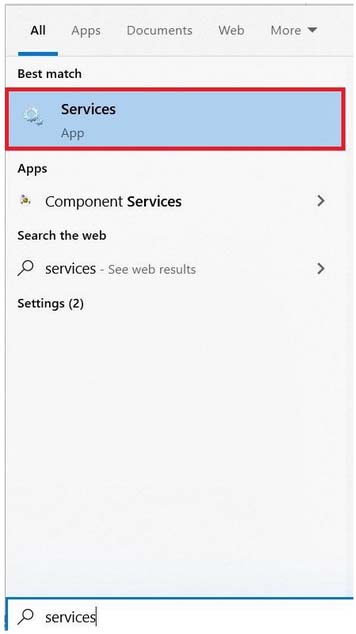
- In the Services window, scroll down to find the “Windows Update” option;
- Right-click the “Windows Update” option and click on “Restart“. Once you do this, the Windows Service will reconnect with the Windows Update servers to detect new updates;

- In Settings, go to the “Windows Updates” tab and check whether new updates are available or not.
Restart the Background Intelligent Transfer Service
If restarting the Update Service doesn’t fix the issue, you can try restarting the Background Intelligent Transfer Service (BITS) to run the Windows update.
This is because Windows Update depends on BITS to download programs and other updates from the MS servers.
Therefore, if this service is inactive or not running properly, your Windows 10 PC will not be able to install the desired updates.
You can restart the BITS in the following way:
- Press the “Windows+R” keys simultaneously to launch the Run Dialog Box;
- Type “services.msc” in the box and “press Enter“;
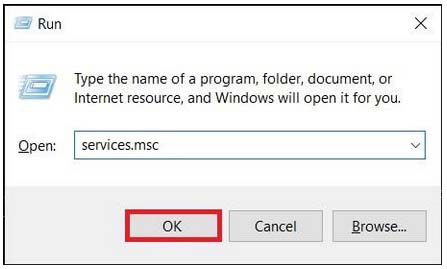
- Locate the “Background Intelligent Transfer Service” in the listed services;
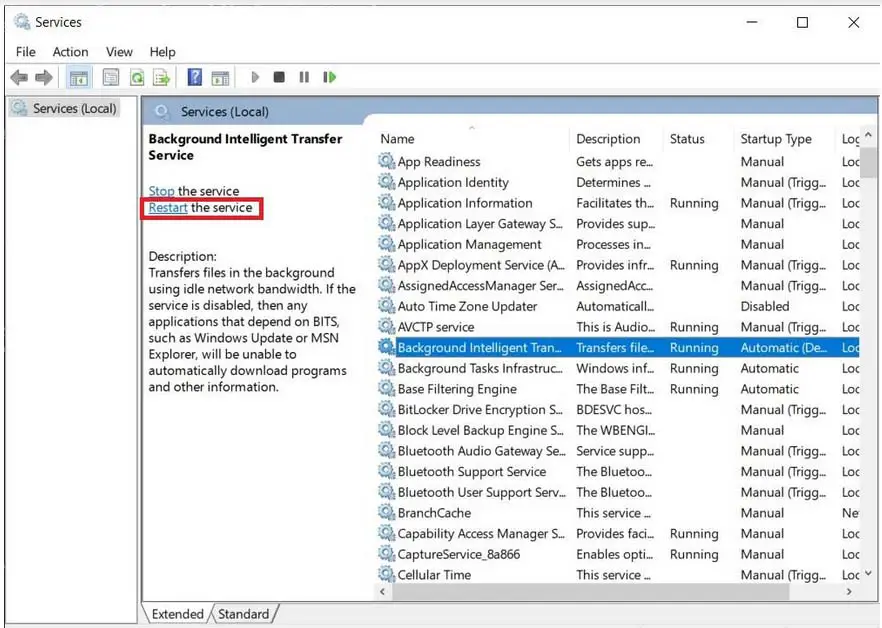
- Click on it, followed by “Restart the service” in the window’s left pane.
If that doesn’t fix the problem with your Windows updates, you can try other troubleshooting methods in this guide.
Perform Disk Cleanup
When a user downloads new OS updates, Windows tend to store the previous system files on the device.
Thus, with the previous files consuming a considerable space on your PC, Windows may not be able to download the latest updates.
Even if they don’t take ample storage space, these files are often corrupted and require immediate removal for future Windows updates to be successful.
Follow the listed steps to get done with the cleanup process:
- Open the “Disk Cleanup” app via the Windows Search bar;

- A drive selection window will pop up. Select the drive you want to clean up;

- Tap on the “Clean up system files” button. Depending upon which drive you’ve selected, the tool will calculate the freeable space on your Windows device;

- Select the drive again;
- Next, check the “Windows Update Cleanup” option and click “Ok” to confirm the changes.

Use Command Line to force Windows Update
If you are into technology, you can use the Command Prompt application to force Windows updates in.
Here’s what you need to do:
- In the Windows Search box, type “Command Prompt” and launch it in administrator mode;

- Type “wuauclt.exe /updatenow” in the command line and press “Enter“. As soon as you do this, Windows will start searching for updates;

- “Open Settings” by pressing the Windows+I” keys;
- Click on the “Update & Security” option;
- Switch to the “Windows Update” tab and tap on the “Check for updates” option. The Windows will display the message “Checking for updates“;
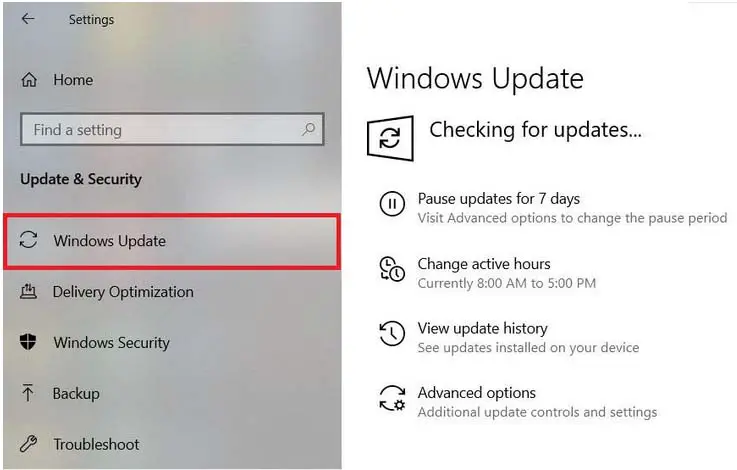
- Finally, follow the instructions on the screen to get done with the Windows 10 installation process.
Using the Windows 10 Update Assistant
Another way to get the latest version of Windows 10 is to directly install it from the official Windows 10 software download page.
This will not only force install an update but will also perform compatibility checks to ensure your Windows 10 PC meets the new Windows build requirements.
- Visit the “Download Windows 10” page using your browser;
- Click on the “Update now” button to quickly install the desired update;

- Once the Windows 10 Upgrade setup file is downloaded, open it and follow the on-screen steps to equip your computer with the latest upgrade.
Force Windows Updates via WuInstall
WuIntsall is a reliable command line tool that manages Windows updates, allowing the users to install the latest builds on demand.
With WuInstall, the admins get to upgrade their systems using their own scripts while having complete control over the update process.
You can use this user-friendly tool either as a standalone fix or combine it with WSUS or other software programs.
The tool is an appropriate solution not only for running a small network but also for a vast network with thousands of servers.
Here’s how you can utilize WuInstall to your benefit:
- Go to “wuinstall.com” and download and install the line command tool. Here, you will have the option of testing the software with a fully functional 30-day trial. If the software matches your system infrastructure, you can then make a complete purchase;
- In the Windows Search box, type “cmd” and open the Command Prompt by clicking on the “Run as administrator” option;
- Now type “wuInstall/search” in the command line and press “Enter“. This command will search and list the relevant Microsoft updates available on your PC;
- Next, type “wuInstall /download” to trigger the download process. The listed updates will be downloaded to your system;
- The last part of this process is to type “wuInstall /install” in the command line and hit “Enter“. Here, the downloaded updates will be installed on the system;
- The installation could take some time, depending upon the speed of your system. Wait for a while until the installation process is finished.
In addition to the above-listed methods, you can also make use of the Microsoft Windows Update Troubleshooter to resolve issues that might be preventing Windows 10 from upgrading itself.
Still unable to force Windows Updates?
There are times when even after trying dozens of methods available on the internet, you wouldn’t be able to force Windows updates.
This is primarily due to a Safeguard Hold that Microsoft places on your affected PC in order to prevent it from downloading a new OS version, which may be incompatible with the system.
Hence, if that’s the case, your Microsoft Windows updates page will display an error message: “The Windows 10 Updates is on its way. Once it’s ready for your device, you’ll see the update available on this page“.
Microsoft highly recommends its users not to manually download a feature update until a renewed and verified version is available for an automatic download.
Just wait for a few days, and the safeguard will be lifted by Microsoft itself.
Wrap up
It’s a known fact that Microsoft rolls out its updates in waves to identify and resolve issues as they occur.
While it’s the best way to ensure a smooth user experience, it’s often frustrating for the users to wait around for months before the updates finally get released for automatic installation.
If you are not in a hurry to test the new version, we encourage you to wait for a while until the update is available for download.
However, if you are tired of the waiting cycle like most Windows users, you can utilize any of the above methods to force an update as soon as it rolls out.
Check out some of our other awesome articles:
- Showing hidden files in Windows 10: how to?
- Discovering the Windows 10 product key
- Setting up dual monitors in Windows 10
- How can I clean install Windows 10?
- Uninstalling Windows 10
- How to change the login password in Windows 10
- Removing Windows 10 password
- Creating a restore point in Windows 10. How to do it?
